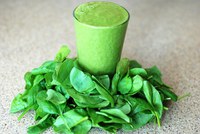Prairie Fare: May Is Melanoma Awareness Month
(Click the image below to view a high-resolution image that can be downloaded)
By Julie Garden-Robinson, food and nutrition specialist
NDSU Extension
In the past year, I have noticed many adults sporting bandages on their noses, chins or backs of their necks.
I do not ask “What happened to you anyway?” I usually have a good idea.
Most will comment that they had skin cancer removed.
Fortunately, in most cases, they have one of the less serious types of skin cancer.
Whenever I see people with bandages on their faces, I tend to examine my own skin more closely.
Is that a harmless freckle or mole – or a potentially cancerous spot?
Skin experts recommend that we know our “A, B, C, D and E’s.” These are the warning signs of potential skin cancer.
- Asymmetry – The halves do not match.
- Borders – Uneven, scalloped or notched.
- Color – Variety of colors including brown, tan, black, red and/or blue.
- Diameter – Usually larger than the size of the eraser on your pencil (1/4 inch).
- Evolving – Look for changes in size, shape, color, elevation or symptoms such as bleeding, itching or crusting.
Skin cancer is the most common type of cancer. Every year about 5 million people are diagnosed with skin cancer according to the Skin Cancer Foundation.
Regardless of our natural skin color, we all face a risk of skin cancer. Caucasian people have a greater risk of skin cancer than those with darker skin. People of color often are diagnosed at a more advanced stage of skin cancer according to the Skin Cancer Foundation.
Skin is the largest organ of the body, and it is comprised of several layers, including the epidermis (outer later) and the dermis (inner layer).
Basal cells, squamous cells and melanocytes are the cells that make up the epidermis, and you may be familiar with their namesake types of skin cancer. Melanocytes contain melanin, the pigment responsible for the darkening of our skin upon exposure to sunlight. “Melanoma” gets its name from melanocytes.
We need to protect our skin in all seasons. Getting a “tan” whether outdoors or from a tanning bed is not healthy. Yes, your body makes vitamin D from exposure to sun, but we do not need a lot of sun exposure. Self-tanning lotions are considered safe.
Melanoma is the most dangerous form of skin cancer, and it is more likely to spread to other parts of the body. With early detection, skin cancer almost always is curable. Be sure to check out any moles, dark spots or growths on your skin.
May is Melanoma Awareness Month. In the Midwest, May brings sunny days, warmer temperatures, gardening, golfing, baseball and numerous outdoor occupational and recreational activities.
Skin cancer can be prevented or deterred with these tips promoted by the North Dakota Cancer Coalition:
- Seek shade from ultraviolet (UV) rays, especially during midday (10 a.m. to 2 p.m.).
- Cover up to protect exposed skin. Wear long sleeves.
- Wear a hat with a wide brim. Ball caps do not protect your ears or the back of your neck.
- Grab shades that block UVA and UVB rays.
- Rub on sunscreen with an SPF of at least 30 and both UVA and UVB protection. Reapply every two hours.
- Talk with a dermatologist for specific product recommendations.
This week I am sharing some resources developed in North Dakota, including a webinar from a cancer survivor. See the fun safety video featuring Parker the Penguin created for kids (or adults who are kids at heart).
Check out the variety of sun safety resources from the North Dakota Cancer Coalition (search online for “ND Cancer Coalition Skin Cancer”).
Skin needs protection and good nutrition to stay healthy, just like the rest of our body. Promote skin health by consuming plenty of fluids, colorful fruits and vegetables, and foods rich in omega-3 fats (such as salmon) as part of a balanced, healthful diet.
For more skin nutrition information, see “Nourish Your Skin” from NDSU Extension for more information (search “NDSU Nourish Your Skin”).
This nutrient-rich smoothie can be frozen in small cups with a plastic spoon as a handle. You can eat it like an ice pop or let it melt slightly to become a slushy fruit and veggie snack.
Pineapple-Mango Green Smoothie
8 ice cubes
1 cup pineapple chunks, diced (fresh or canned in juice)
1 large mango, diced
2 cups fresh spinach leaves
1/2 cup pineapple juice
1/2 teaspoon coconut extract
Place ingredients in blender or food processor in the order written. Blend until smooth.
Makes four servings. Each serving has 80 calories, 0 grams (g) fat, 0 g protein, 20 g carbohydrate, 2 g fiber and 15 milligrams sodium.
(Julie Garden-Robinson, Ph.D., R.D., L.R.D., is a North Dakota State University Extension food and nutrition specialist and professor in the Department of Health, Nutrition and Exercise Sciences. Follow her on Twitter @jgardenrobinson)
NDSU Agriculture Communication – May 5, 2022
Source: Julie Garden-Robinson, 701-231-7187, julie.garden-robinson@ndsu.edu
Editor: Elizabeth Cronin, 701-231-5391, elizabeth.cronin@ndsu.edu


